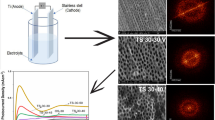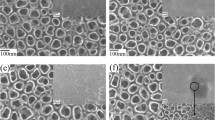Abstract
The photoelectrical properties of highly ordered TiO2 nanotube (TNT) arrays have been systematically and quantitatively studied and found to be closely related to their geometric and crystal structures. The geometric characteristics, including the nanotube diameter and length, were modified by adjusting the anodization potentials and durations, while the crystal structure was modified by thermal annealing at different temperatures. The nanotube array samples with the mixed crystalline phases possess higher photoconversion efficiency than those with the single anatase or rutile phase. The optimal content of rutile phase is about twice of that of anatase phase. In terms of the influence of the geometric structure, the TNT arrays with larger inner diameters and longer tube lengths have better photoelectrical properties. A geometric roughness factor has been applied to describe the combinative effect of the geometric characteristics. The TNT sample with the geometric roughness factor of 125.32 shows the superior photoconversion efficiency of 13.2%. The underlying mechanism has also been discussed in detail.









Similar content being viewed by others
References
N. Baram and Y. Ein-Eli: Electrochemical impedance spectroscopy of porous TiO2 for photocatalyst applications. J. Phys. Chem. C 114, 9781 (2010).
K. Shankar, M. Paulose, G.K. Mor, O.K. Varghese, and C.A. Grimes: A study on the spectral photoresponse and photoelectrochemical properties of flame-annealed titania nanotube-arrays. J. Phys. D: Appl. Phys. 38, 3543 (2005).
M. Law, L.E. Greene, J.C. Johnson, R. Saykallyi, and P.D. Yang: Nanowire dye-sensitized solar cells. Nat. Mater. 4, 455 (2005).
A.J. Frank, N. Kopidakis, and J. van de Lagenmaat: Electrons in nanostructured TiO2 solar cells: Transport, recombination and photovoltaic properties. Coord. Chem. Rev. 248, 1165 (2004).
G.K. Mor, K. Shankar, M. Paulose, O.K. Varghese, and C.A. Grimes: Use of highly-ordered TiO2 nanotube arrays in dye-sensitized solar cells. Nano Lett. 6, 215 (2006).
M. Paulose, K. Shankar, S. Yoriya, H.E. Prakasam, O.K. Varghese, P.K. Mor, T.A. Latempa, A. Fitzgerald, and C.A. Grimes: Anodic growth of highly ordered TiO2 nanotube arrays to 134 μm in length. J. Phys. Chem. B 110, 16179 (2006).
N.K. Allam, A.J. Poncher, and M.A. El-Sayed: Vertically oriented Ti-Pd mixed oxynitride nanotube arrays for enhanced photoelectrochemical water splitting. ACS Nano 5, 5056 (2011).
J.M. Macak, H. Tsuchiya, A. Ghicov, K. Yasuda, R. Hahn, S. Bauer, and P. Schmuki: TiO2 nanotubes: Self-organized electrochemical formation, properties and applications. Curr. Opin. Solid State Mater. Sci. 11, 4 (2007).
C.A. Grimes: Synthesis and application of highly ordered arrays of TiO2 nanotubes. J. Mater. Chem. 17, 1451 (2007).
S. Yoriya, M. Paulose, O.K. Varghese, G.K. Mor, and C.A. Grimes: Fabrication of vertically oriented TiO2 nanotube arrays using dimethyl sulfoxide electrolytes. J. Phys. Chem. C 111, 13770 (2007).
D.W. Gong, C.A. Grimes, and O.K. Varghese: Titanium oxide nanotube arrays prepared by anodic oxidation. J. Mater. Res. 16, 3334 (2001).
K. Shankar, G.K. Mor, H.E. Prakasam, S. Yoriya, M. Paulose, O.K. Varghese, and C.A. Grimes: Highly-ordered TiO2 nanotube arrays up to 220 μm in length: Use in water photoelectrolysis and dye-sensitized solar cells. Nanotechnology 18, 065707 (2007).
S.K. Mohapatra, K.S. Raja, V.K. Mahajan, and M. Misra: Efficient photoelectrolysis of water using TiO2 nanotube arrays by minimizing recombination losses with organic additives. J. Phys. Chem. C 112, 11008 (2008).
L.D. Sun, S. Zhang, X.W. Sun, and X.D. He: Effect of geometry of the anodized titania nanotube array on the performance of dye-sensitized solar cells. J. Nanosci. Nanotechnol. 10, 4554 (2010).
A. Atyaoui, L. Bousselmi, H. Cachet, P. Pu, and E.M.M. Sutter: Influence of geometric and electronic characteristics of TiO2 electrodes with nanotubular array on their photocatalytic efficiencies. J. Photochem. Photobiol. Chem. 224, 72 (2011).
W. Zhu, X. Liu, H.Q. Liu, D. Tong, J.Y. Yang, and J.Y. Peng: An effect approach to control the morphology and the adhesion properties of anodized TiO2 nanotube arrays for improved photoconversion efficiency. Electrochim. Acta 56, 2619 (2011).
X.H. Tang and D.Y. Li: Fabrication, geometry, and mechanical properties of highly ordered TiO2 nanotubular arrays. J. Phys. Chem. C 113, 7107 (2009).
K. Shankar, G.K. Mor, M. Paulose, O.K. Varghese, and C.A. Grimes: Effect of device geometry on the performance of TiO2 nanotube array-organic semiconductor double heterojunction solar cells. J. Non-Cryst. Solids 354, 2768 (2008).
G.K. Mor, O.K. Varghese, M. Paulose, K. Shankar, and C.A. Grimes: A review on highly ordered, vertically oriented TiO2 nanotube arrays: Fabrication, metal properties, and solar energy applications. Sol. Energy Mater. Sol. Cells 90, 2035 (2006).
Y. Sun, K.P. Yan, G.X. Wang, W. Guo, and T.L. Ma: Effect of annealing temperature on the hydrogen production of TiO2 nanotube arrays in a two-compartment photoelectrochemical cell. J. Phys. Chem. C 115, 12846 (2011).
H.Z. Zhang and J.F. Banfield: Understanding polymorphic phase transformation behavior during growth of nanocrystalline aggregates: Insights from TiO2. J. Phys. Chem. B 104, 3482 (2000).
N.K. Allam and C.A. Grimes: Effect of rapid infrared annealing on the photoelectrochemical properties of anodically fabricated TiO2 nanotube arrays. J. Phys. Chem. C 113, 7998 (2009).
Z.B. Chen, T.F. Jaramillo, T.G. Deutsch, A. Kleiman-Shwarsctein, A.J. Forman, N. Gaillard, R. Garland, K. Takanabe, C. Heske, M. Sunkara, E.W. McFarland, K. Domen, and E.L. Miller: Accelerating materials development for photoelectrochemical hydrogen production: Standards for methods, definitions, and reporting protocols. J. Mater. Res. 25, 7 (2010).
C.M. Run, M. Paulose, O.K. Vrghese, and C.A. Grimes: Enhanced photoelectrochemica-response in highly ordered TiO2 nanotube-arrays anodized in boric acid containing electrolyte. Sol. Energy Mater. Sol. Cells 90, 1291 (2006).
X.B. Chen, S.H. Shen, L.J. Guo, and S.S. Mao: Semiconductor-based photocatalytic hydrogen generation. Chem. Rev. 110, 6528 (2010).
A. Kar, R. Pando, and V.R. Subramanian: Photoelectrochemical response of anodized titanium oxide films. J. Mater. Res. 25, 82 (2010).
K. Shankar, J.I. Basham, N.K. Allam, O.K. Varghese, G.K. Mor, X.L. Feng, M. Paulose, J.A. Seabold, K.-S. Choi, and C.A. Grimes: Recent advances in the use of TiO2 nanotube and nanowire arrays for oxidative photoelectrochemistry. J. Phys. Chem. C 113, 6335 (2009).
K. Zhu, N.R. Neale, A. Miedaner, and A.J. Frank: Enhanced charge-collection efficiencies and light scattering in dye-sensitized solar cells using oriented TiO2 nanotubes arrays. Nano Lett. 7, 71 (2007).
M. Kawakita, J. Kawakita, Y. Sakka, and T. Shinohara: Photoelectrochemical evaluation of anatase TiO2 polycrystalline aggregation layers with different crystalline orientations. J. Mater. Res. 25, 67 (2010).
Acknowledgments
We acknowledge Mr. Guizhen Wang for the analysis of scanning electron microscopy in the Analytical and Testing Center of Hainan University. This work was supported by Program for New Century Excellent Talents in University (NCET-09-0110), the Key Project of Chinese Ministry of Education (210171), and the National Nature Science Foundation of China (51162007).
Author information
Authors and Affiliations
Corresponding author
Rights and permissions
About this article
Cite this article
Li, D., Lin, S., Li, S. et al. Effects of geometric and crystal structures on the photoelectrical properties of highly ordered TiO2 nanotube arrays. Journal of Materials Research 27, 1029–1036 (2012). https://doi.org/10.1557/jmr.2012.38
Received:
Accepted:
Published:
Issue Date:
DOI: https://doi.org/10.1557/jmr.2012.38




